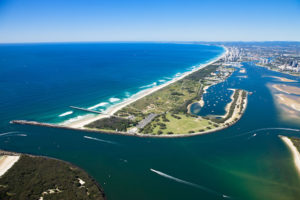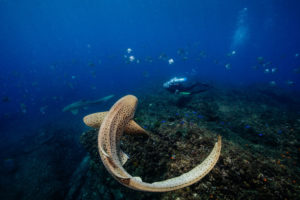Gold Coast Bay is this week being declareda Mission Blue Hope Spot becoming part of a worldwide network thatraisespublic awarenessofmarine protected areas.
To coincide with the Ocean-themed National Science Week, Mission Blue and Griffith Climate Change Response Program (GCCRP), together with a host of ocean-based industry partners in the region have recognised the importance of this marine system by designating it as a Hope Spot.
“The ocean is a part of the city,and the health of its economy is dependent on that ocean being healthy,”saidDr OlafMeynecke, Hope Spot Champion from the Griffith Centre for Coastal Management (GCCM).

Gold Coast Bay, photo credit: Humpbacks & Highrise Inc
“Under the Mission Blue Hope Spot umbrella, the Gold Coast will find its place among other iconic marine environments. It will bring business, community groups and the university sector together to work towards sustainable uses of the Gold Coast Bay, which ensure a healthy coastal environment.”
Stretching from Tweed Heads to North Stradbroke Island,the rugged reefs and sheltered waters of Gold CoastBay provide a nursery grounds for a rich variety of marine life including 400 species of fish,four types of sea turtles, sharks, dolphins, dugongs and of course whales.
“But despite being a key resting ground for humpback whales and their calves the bay still remains unprotected,’’ Dr Meynecke said.
Professor Brendan Mackey, Director of the Griffith Climate Action Beacon said the whale watching industry was a magnet for tourists and a vital component of the Gold Coast’s economy.
“Recognition of the Gold Coast as Mission Blue Hot Spot is a huge boost for the tourist industry and the local economy, as well as being good for the whales.”
But as Dr Meynecke explains, “if the current trends on the Gold Coast continue, sensitive whale populations and other iconic marine wildlife could be threatened, particularly by through habitat modification, noise and water pollution, overfishing and entanglement in shark nets.”
As part of the Gold Coast Bay Hope Spot declaration partners are working to minimise these threats.
Strategies include go-slow zones in areas rich marine wildlife, establishing mooring lines and no-anchor zones around inshore reefs, replacing shark nets with more effective non-lethal methods, scientific assessment of planned developments, declaration of the Gold Coast Bay as an official resting and calving ground for Humpback whales and education/celebration of a clean ocean-based culture.

Palm Beach reef, Gold Coast Bay, photo credit: SEA The Gold Coast.
Renowned oceanographer and founder of Mission Blue, Dr Sylvia Earle, has created a global network of Hope Spots, to inspire an upwelling of public awareness, access and support for a worldwide network of marine protected areas.
“For thousands of years, nature’s intricate interrelationships have allowed migratory species to flourish while moving through the seas. It’s so important that people are aware of the creatures that they share the ocean with.
“I applaud the Hope Spot Champions and their partners for coming together and joining forces to protect the Gold Coast Bay for not only Australia but for the entire planet.”
The Griffith Climate Change Response Program and the Whales & Climate Research project have provided scientific data to validate the significance of the Gold Coast marine environment.
“The classification of the Gold Coast as a marine Hope Spot will foster new research opportunities on the coastal environment for Griffith research centres like the GCCRP, GCCM, Australian Rivers Institute, the Cities Research Institute’s Sea Cities project and others working towards sustainable use of marine environments,” Dr Meynecke said.
